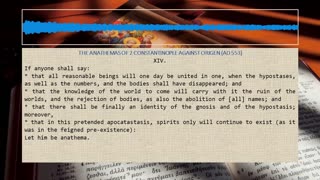Premium Only Content

Idol Killer Interview 2 Augustine’s Contribution to Penal-Substitutionary Atonement
Although Augustine of Hippo is not a name that theologians associate with penal-substitutionary atonement (PSA), the dogma would not exist without him, as Anselm of Canterbury built his medieval model of atonement atop Augustine’s three anthropological ideas of original sin, total depravity, and infant depravity.
Paul begins with the definition of soteriology, which deals with theories of salvation, and anthropology, which pertains to theories concerning humankind. Augustine, a North-African theologian whose dates are AD 354-430, is credited with formulating the anthropology that underpins the PSA model of atonement. Augustine's anthropology is characterized by the beliefs in original sin, total depravity, and infant depravity. Anselm of Canterbury, a medieval theologian (1033-1109), built upon Augustine's anthropology and presented nine soteriological claims that form the foundation of the medieval and modern penal substitutionary model of atonement. However, as noted by the hosts, several of Anselm's claims are not biblically sound and were influenced by the cultural climate of the time. Nonetheless, Anselm did not introduce these ideas in a vacuum, and they were based on the already esteemed Augustinian anthropology.
Augustine's writings account for 21% of the writings in the Schaff collection of Church Fathers, underlining his substantial impact on both Catholicism and Protestantism. Original sin, the first claim in PSA, stems from Augustine's teachings on mankind's guilt due to Adam's sin. However, as Paul points out, the biblical refutation of this claim in Ezekiel 18:20, Jeremiah 31:30, and Deuteronomy 24:16 states that every person is responsible for his or her own sin and shall bear the consequences thereof himself or herself. Where did Augustine get such an obviously unbiblical notion as original sin? The answer is that he got it from reading a questionable translation of Romans through Manichean-colored lenses. The hosts’ ensuing discussion of the Latin and Greek renderings of Romans 5;21 is precising yet gripping.
Total depravity, though linked to John Calvin, originates in Augustine’s writings. Augustine used Psalm 51;5 as evidence of total depravity: "Behold, I was shapen in iniquity, and in sin did my mother conceive me." However, Paul points out that a different interpretation can be found in Romans 2;14, where it is suggested that Gentiles, who do not have the law, still naturally follow the principles contained within it. Indeed, the Augustinian perspective raises questions about the existence of natural law and universal moral values. Furthermore, Paul questions the interpretation of Psalm 51:5, suggesting alternative interpretations that do not embrace the idea of inheriting a sinful nature. Paul uses the case of Jephthah, a Biblical character who was the son of a prostitute and was rejected by his siblings, suggesting that David might likewise have been illegitimate.
Regarding infant depravity, Paul argues that Augustinians struggle to reconcile this belief with their opposition to abortion and misunderstand the purpose of baptism for babies. Although baptism is believed to wash away sins, babies do not have actual sins. Paul explains that baptism has three aspects: initiation, identification, and purification. The initiation and identification aspects apply to both adults and babies, as they mark the entrance into the covenant community and the identification with Christ, respectively. The purification aspect, which signs the washing away of sins, does not apply to babies since they do not have sin. Paul uses Colossians 2:11-13 to illustrate these concepts.
-
 1:23
1:23
Paul Vendredi
16 days ago2 Constantinople - Anathemas 14-15
111 -
 LIVE
LIVE
Geeks + Gamers
44 minutes agoMario Kart World LIVE - Nintendo Switch 2
126 watching -
 LIVE
LIVE
VapinGamers
1 hour agoEtheria: Restart - Game Review and Playthru - !game !rumbot
57 watching -
 LIVE
LIVE
Spartan
8 hours agoFirst esports Pro on Rumble! | Pro Halo Player | Ranked on Halo Infinite
187 watching -
 13:55
13:55
Degenerate Jay
2 hours agoIs This The New Metal Gear Online? - Fox Hunt Has A Lot To Prove
3.12K2 -
 11:56
11:56
Freedom Frontline
2 hours agoThis Is The ONLY Decent Interview Kaitlan Collins Has Ever Done
19.6K5 -
 30:00
30:00
BEK TV
23 hours agoCovenants, Oppression, and Blocking Demons from Entering Our Home - Vicki Joy Anderson
1.05K -
 1:03:58
1:03:58
BonginoReport
5 hours agoDem Leaders Want YOU to Fund Nonsensical Policies - Nightly Scroll w/ Hayley Caronia (Ep.72)
118K48 -
 2:45:48
2:45:48
WickedVirtue
3 hours agoFive Nights At Freddy's is HERE!
34.1K2 -
 1:10:32
1:10:32
TheCrucible
5 hours agoThe Extravaganza! EP: 07 (6/18/25)
118K13